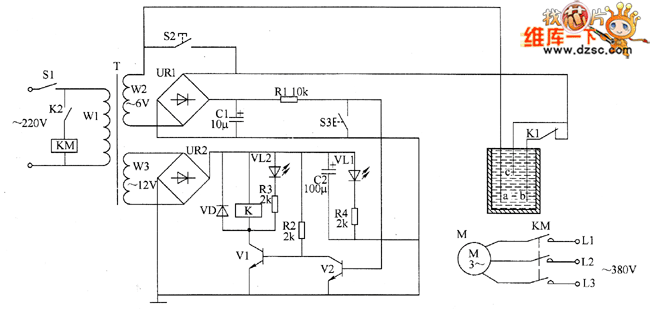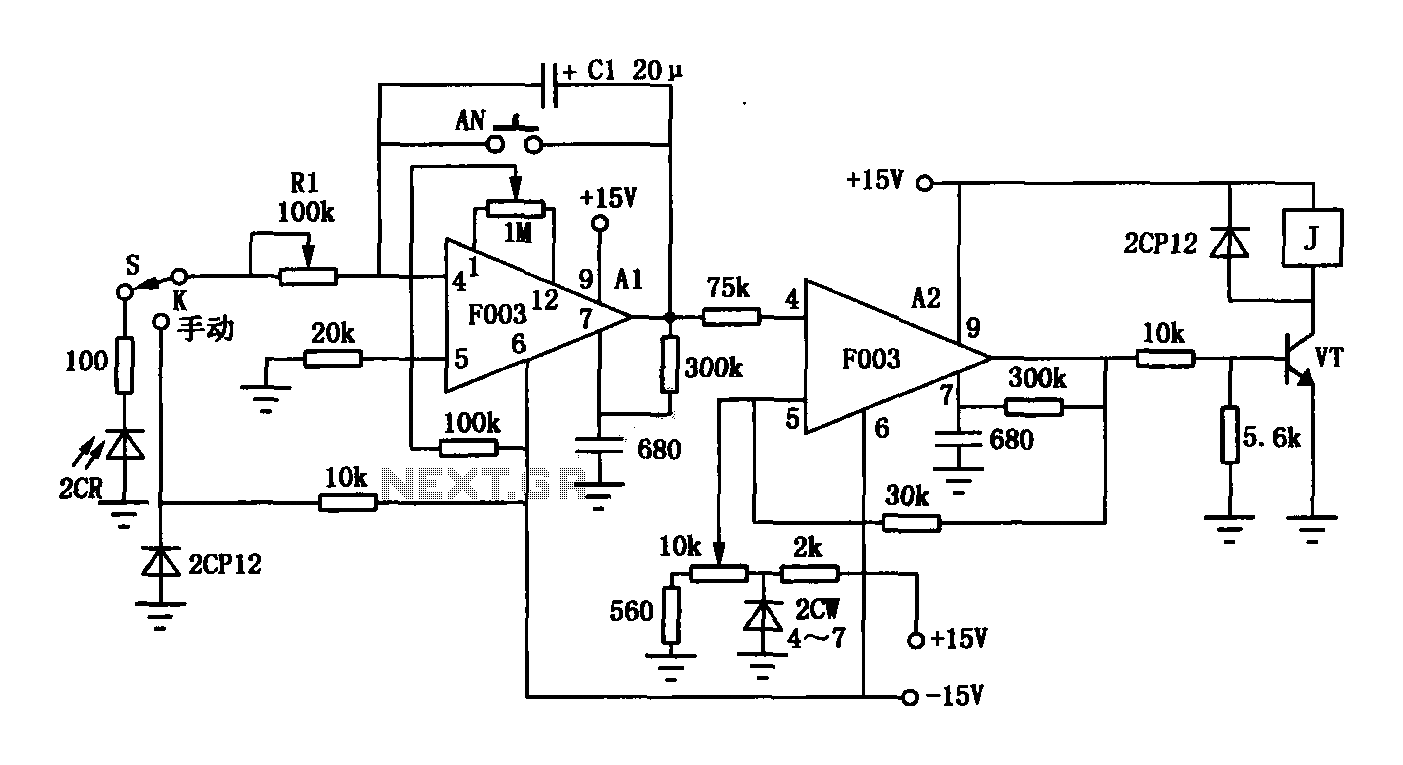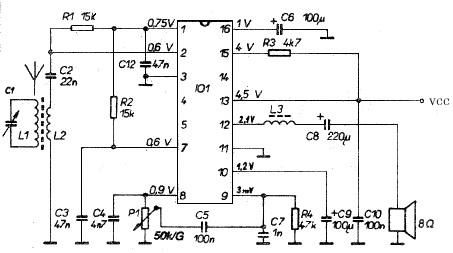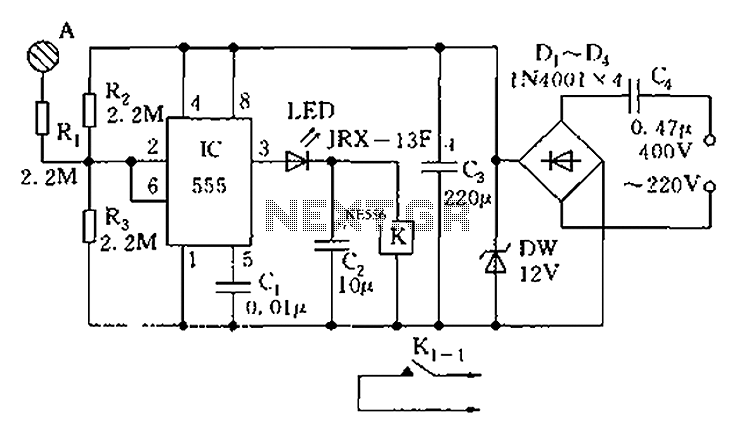
Simplest RF Transmitter circuit diagram
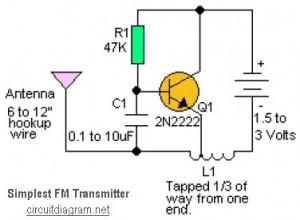
This is likely the simplest radio transmitter available, consisting of five components and capable of being assembled in a compact space. It is suitable for science fair projects or other science-related endeavors where short-range transmission is beneficial. The device operates on a voltage range of 1.5 to 3 volts, making small hearing aid batteries or lithium coin cells ideal power sources. A thermistor or photoresistor can be added in series with R1 to create a variable output frequency based on the input. The output frequency can also be adjusted by changing the capacitance of C1. While a 2N2222 transistor is recommended, other types may also be used, although performance may vary between different transistors. The inductor L1 consists of 20 to 30 turns of thin magnet wire (24 to 32 gauge), tightly wound around a non-conductive form with a diameter of 1/8 to 1/4 inches. The coil is tapped approximately one-third of the way from one end, with the tap connected to the emitter of Q1. Experimentation with the circuit values is encouraged, as no components are critical, but performance can vary significantly.
The circuit operates as a basic radio transmitter, utilizing a few fundamental components that work together to generate and modulate radio frequency signals. The core of the circuit includes a transistor (Q1), which acts as the amplifying element. The transistor is biased correctly to allow it to operate in its active region, enabling it to amplify the input signal.
The inductor (L1) plays a crucial role in determining the frequency of the transmitted signal. By adjusting the number of turns in the coil or changing the diameter of the coil form, the inductance can be modified. This, combined with the capacitive element (C1), forms a resonant LC circuit, where the frequency of oscillation can be calculated using the formula \( f = \frac{1}{2\pi\sqrt{LC}} \). This relationship highlights the importance of both L1 and C1 in tuning the transmitter to the desired frequency.
The resistor (R1) and the optional thermistor or photoresistor introduce variability into the circuit, allowing for dynamic control of the output frequency based on environmental conditions such as temperature or light levels. This feature can be particularly useful in educational projects where demonstrating the principles of radio frequency transmission and modulation is the goal.
The power supply, ranging from 1.5 to 3 volts, should be chosen based on the availability of batteries and the desired operating time of the transmitter. The use of hearing aid batteries or lithium coin cells is recommended due to their compact size and adequate voltage output for the circuit's requirements.
Overall, this simple radio transmitter circuit provides an excellent platform for experimentation and learning, allowing users to explore the fundamentals of radio transmission and the impact of various component values on circuit performance.This is probably the simplest radio transmitter that you will find anywhere. It has a total of five parts and can be constructed into a very small space. It is great for science fair projects or other science related projects where short range transmission is useful. It runs on 1. 5 to 3 Volts, with small hearing aid batteries or lithium coin ce lls being ideal. A thermistor or photoresistor can be inserted in series with R1 to have a varying output frequency dependent on the input. The frequency can also be changed by changing the value of C1. A 2N2222 transistor is recommended, but you can try other types also. Performance tends to vary from type to type as well as from transistor to transistor. L1 is 20 to 30 turns of thin magnet wire (24 to 32 ga. ) close wound around a 1/8 to 1/4 ³ diameter non-conductive form. The coil is tapped 1/3 of the way from one end and the tap connected to the emitter of Q1. Experiment with all of the values in this circuit. Nothing is critical, but performance can be varied considerably. 🔗 External reference
The circuit operates as a basic radio transmitter, utilizing a few fundamental components that work together to generate and modulate radio frequency signals. The core of the circuit includes a transistor (Q1), which acts as the amplifying element. The transistor is biased correctly to allow it to operate in its active region, enabling it to amplify the input signal.
The inductor (L1) plays a crucial role in determining the frequency of the transmitted signal. By adjusting the number of turns in the coil or changing the diameter of the coil form, the inductance can be modified. This, combined with the capacitive element (C1), forms a resonant LC circuit, where the frequency of oscillation can be calculated using the formula \( f = \frac{1}{2\pi\sqrt{LC}} \). This relationship highlights the importance of both L1 and C1 in tuning the transmitter to the desired frequency.
The resistor (R1) and the optional thermistor or photoresistor introduce variability into the circuit, allowing for dynamic control of the output frequency based on environmental conditions such as temperature or light levels. This feature can be particularly useful in educational projects where demonstrating the principles of radio frequency transmission and modulation is the goal.
The power supply, ranging from 1.5 to 3 volts, should be chosen based on the availability of batteries and the desired operating time of the transmitter. The use of hearing aid batteries or lithium coin cells is recommended due to their compact size and adequate voltage output for the circuit's requirements.
Overall, this simple radio transmitter circuit provides an excellent platform for experimentation and learning, allowing users to explore the fundamentals of radio transmission and the impact of various component values on circuit performance.This is probably the simplest radio transmitter that you will find anywhere. It has a total of five parts and can be constructed into a very small space. It is great for science fair projects or other science related projects where short range transmission is useful. It runs on 1. 5 to 3 Volts, with small hearing aid batteries or lithium coin ce lls being ideal. A thermistor or photoresistor can be inserted in series with R1 to have a varying output frequency dependent on the input. The frequency can also be changed by changing the value of C1. A 2N2222 transistor is recommended, but you can try other types also. Performance tends to vary from type to type as well as from transistor to transistor. L1 is 20 to 30 turns of thin magnet wire (24 to 32 ga. ) close wound around a 1/8 to 1/4 ³ diameter non-conductive form. The coil is tapped 1/3 of the way from one end and the tap connected to the emitter of Q1. Experiment with all of the values in this circuit. Nothing is critical, but performance can be varied considerably. 🔗 External reference
